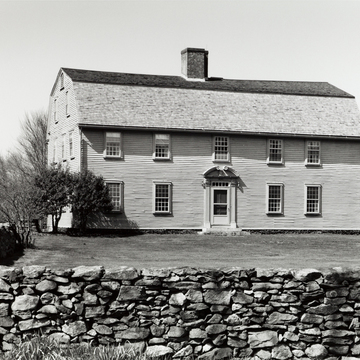Few Narragansett Planter houses exist. This is the finest and very much the largest. It must be the largest eighteenth-century central-chimney gambrel house of its size in the state, testing the limits to which this inherently cozy format can be inflated. Indeed, its impressive scale combines with austerity of treatment to give it a rather barnlike quality, which is enhanced by its uncompromising situation in a skewed position at the center of a handsomely stone-walled field. Large as it is, however, at its grandest it was approximately 110 feet long, or nearly twice the 60-foot length that now exists; the extension, added by Rowland Robinson II, grandson of the original owner, was given over to service facilities and slave quarters. The grand door with its broken-segmental-arch pediment, an echo of that on the second-story balcony of the Colony House in Newport, is the sole adornment of this severity. It was no doubt added during the late 1920s restoration by Norman Isham, who knew the Colony House intimately after his work there in 1917.
You are here
Rowland Robinson House
1710. 1755, remodeling and enlargement, Rowland Robinson II. c. 1928, restoration and addition of rear servants' ell, Norman M. Isham. 450 Old Boston Neck Rd.
If SAH Archipedia has been useful to you, please consider supporting it.
SAH Archipedia tells the story of the United States through its buildings, landscapes, and cities. This freely available resource empowers the public with authoritative knowledge that deepens their understanding and appreciation of the built environment. But the Society of Architectural Historians, which created SAH Archipedia with University of Virginia Press, needs your support to maintain the high-caliber research, writing, photography, cartography, editing, design, and programming that make SAH Archipedia a trusted online resource available to all who value the history of place, heritage tourism, and learning.














